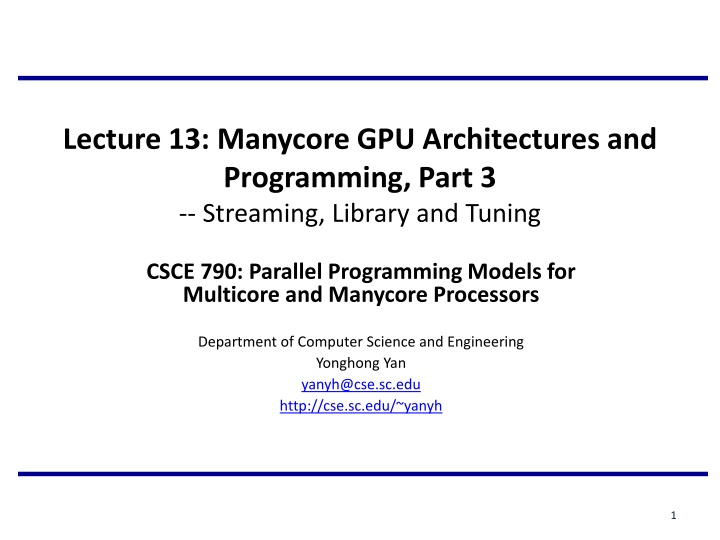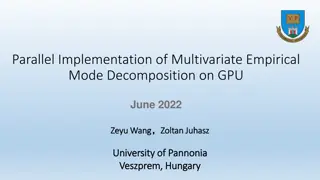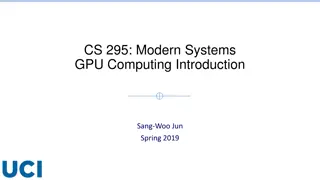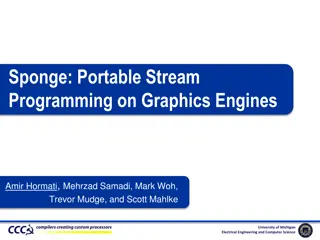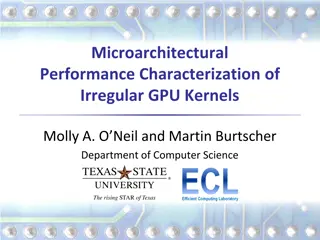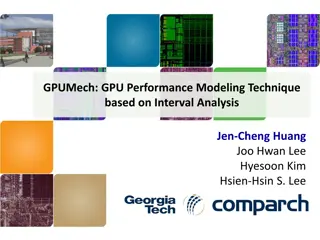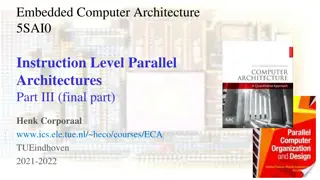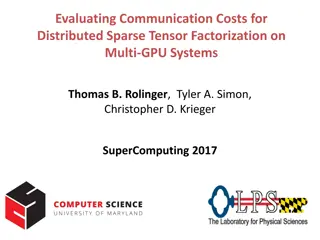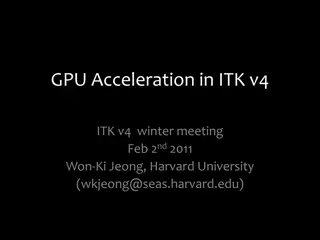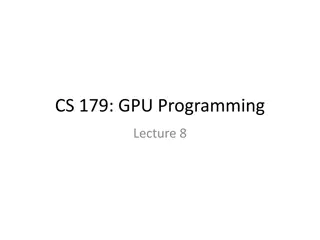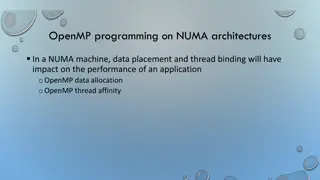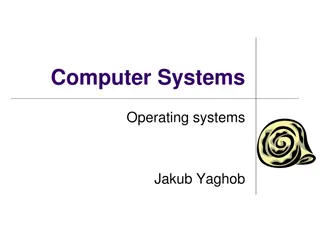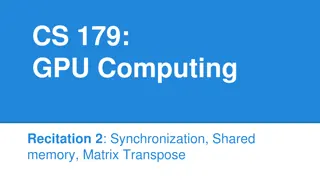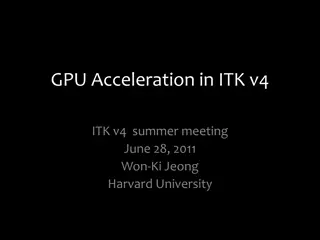Lecture 13: Manycore GPU Architectures and Programming, Part 3
overlapping communication and computation in manycore GPU architectures. Learn about CUDA streams, different types of overlap techniques, and how to create, manage, and synchronize actions in CUDA streams efficiently.
Download Presentation

Please find below an Image/Link to download the presentation.
The content on the website is provided AS IS for your information and personal use only. It may not be sold, licensed, or shared on other websites without obtaining consent from the author.If you encounter any issues during the download, it is possible that the publisher has removed the file from their server.
You are allowed to download the files provided on this website for personal or commercial use, subject to the condition that they are used lawfully. All files are the property of their respective owners.
The content on the website is provided AS IS for your information and personal use only. It may not be sold, licensed, or shared on other websites without obtaining consent from the author.
E N D
Presentation Transcript
Lecture 13: Manycore GPU Architectures and Programming, Part 3 -- Streaming, Library and Tuning CSCE 790: Parallel Programming Models for Multicore and Manycore Processors Department of Computer Science and Engineering Yonghong Yan yanyh@cse.sc.edu http://cse.sc.edu/~yanyh 1
Overlapping Communication and Computation Three sequential steps for a single kernel execution Multiple kernels Asynchrony is a first-class citizen of most GPU programming frameworks Computation-communication overlap is a common technique in GPU programming GPU Compute Compute Compute Compute PCIe Bus Copy Copy Copy Copy Copy 2
Abstract Concurrency Different kinds of action overlap are possible in CUDA? 1. Overlapped host computation and device computation 2. Overlapped host computation and host-device data transfer 3. Overlapped host-device data transfer and device computation 4. Concurrent device computation CUDA Streams to achieve each of these types of overlap 3
CUDA Streams CUDA Streams: a FIFO queue of CUDA actions to be performed Placing a new action at the head of a stream is asynchronous Executing actions from the tail as CUDA resources allow Every action (kernel launch, cudaMemcpy, etc) runs in an implicit or explicit stream tail head CUDA Stream CUDA Runtime & GPU CUDA Application Kernel cudaMemcpy cudaMemcpy 4
CUDA Streams Two types of streams in a CUDA program The implicitly declared stream (NULL stream) Explicitly declared streams (non-NULL streams) Up until now, all code has been using the NULL stream by default cudaMemcpy(...); kernel<<<...>>>(...); cudaMemcpy(...); Non-NULL streams require manual allocation and management by the CUDA programmer 5
CUDA Streams To create a CUDA stream: cudaError_t cudaStreamCreate(cudaStream_t *stream); To destroy a CUDA stream: cudaError_t cudaStreamDestroy(cudaStream_t stream); To wait for all actions in a CUDA stream to finish: cudaError_t cudaStreamSynchronize(cudaStream_t stream); To check if all actions in a CUDA stream have finished: cudaError_t cudaStreamQuery(cudaStream_t stream); 6
CUDA Streams cudaMemcpyAsync: Asynchronous memcpy cudaError_t cudaMemcpyAsync(void *dst, const void *src, size_t count, cudaMemcpyKind kind, cudaStream_t stream = 0); cudaMemcpyAsync does the same as cudaMemcpy, but may return before the transfer is actually complete Pinned host memory is a requirement for cudaMemcpyAsync Memory that is resident in physical memory pages, and cannot be swapped out, also referred as page-locked Recall malloc normally reserve virtual address space first and then actually physical pages are allocated 7
CUDA Streams Performing a cudaMemcpyAsync: page-locked memory allocation int *h_arr, *d_arr; cudaStream_t stream; cudaMalloc((void **)&d_arr, nbytes); cudaMallocHost((void **)&h_arr, nbytes); cudaStreamCreate(&stream); Call return before transfer complete cudaMemcpyAsync(d_arr, h_arr, nbytes, cudaMemcpyHostToDevice, stream); ... cudaStreamSynchronize(stream); cudaFree(d_arr); cudaFreeHost(h_arr); cudaStreamDestroy(stream); Do something while data is being moved Sync to make sure operations complete 8
CUDA Streams Associate kernel launches with a non-NULL stream Note that kernels are always asynchronous kernel<<<nblocks, threads_per_block, smem_size, stream>>>(...); The effects of cudaMemcpyAsync and kernel launching Operations are put in the stream queue for execution Actually operations may not happen yet Host-side timer to time those operations Not the actual time of the operations 9
CUDA Streams Vector sum example, A + B = C NULL stream Copy A Copy B vector_sum<<<...>>> Copy C Partition the vectors and use CUDA streams to overlap copy and compute Stream A A B v_s C Stream B A B v_s C Stream C A B v_s C Stream D A B v_s C 10
CUDA Streams How can this be implemented in code? for (int i = 0; i < nstreams; i++) { int offset = i * eles_per_stream; cudaMemcpyAsync(&d_A[offset], &h_A[offset], eles_per_stream * sizeof(int), cudaMemcpyHostToDevice, streams[i]); cudaMemcpyAsync(&d_B[offset], &h_B[offset], eles_per_stream * sizeof(int), cudaMemcpyHostToDevice, streams[i]); vector_sum<<<..., streams[i]>>>(d_A + offset, d_B + offset, d_C + offset); cudaMemcpyAsync(&h_C[offset], &d_C[offset], eles_per_stream * sizeof(int), cudaMemcpyDeviceToHost, streams[i]); } for (int i = 0; i < nstreams; i++) cudaStreamSynchronize(streams[i]); 11
CUDA Events Timing asynchronous operations Host-side timer: only measure the time for the call, not the actual time for the data movement or kernel execution Events to streams, which mark specific points in stream execution Copy A Copy B vector_sum<<<...>>> Copy C Event Events are manually created and destroyed: cudaError_t cudaEventCreate(cudaEvent_t *event); cudaError_t cudaEventDestroy(cudaEvent_t *event); 12
CUDA Events To add an event to a CUDA stream: cudaError_t cudaEventRecord(cudaEvent_t event, cudaStream_t stream); Copy A Copy B vector_sum<<<...>>> Copy C Event Event marks the point-in-time after all preceding actions in stream complete, and before any actions added after cudaEventRecord run Host to wait for some CUDA actions to finish cudaError_t cudaEventSynchronize(cudaEvent_t event); Wait for all the operations before this events to complete, but not those after 13
CUDA Events Check if an event has been reached without waiting for it: cudaError_t cudaEventQuery(cudaEvent_t event); Get the elapsed milliseconds between two events: cudaError_t cudaEventElapsedTime(float *ms, cudaEvent_t start, cudaEvent_t stop); Copy A Copy B vector_sum<<<...>>> Copy C start stop 14
CUDA Events In codes: float time; cudaEvent_t start, stop; cudaEventCreate(&start); cudaEventCreate(&stop); cudaEventRecord(start); kernel<<<grid, block>>>(arguments); cudaEventRecord(stop); cudaEventSynchronize(stop); cudaEventElapsedTime(&time, start, stop); cudaEventDestroy(start); cudaEventDestroy(stop); 15
Implicit and Explicit Synchronization Two types of host-device synchronization: Implicit synchronization causes the host to wait on the GPU, but as a side effect of other CUDA actions Explicit synchronization causes the host to wait on the GPU because the programmer has asked for that behavior 16
Implicit and Explicit Synchronization Five CUDA operations that include implicit synchronization: 1. A pinned host memory allocation (cudaMallocHost, cudaHostAlloc) 2. A device memory allocation (cudaMalloc) 3. A device memset (cudaMemset) 4. A memory copy between two addresses on the same device (cudaMemcpy(..., cudaMemcpyDeviceToDevice)) 5. A modification to the L1/shared memory configuration (cudaThreadSetCacheConfig, cudaDeviceSetCacheConfig) 17
Implicit and Explicit Synchronization Four ways to explicitly synchronize in CUDA: 1. Synchronize on a device cudaError_t cudaDeviceSynchronize(); 2. Synchronize on a stream cudaError_t cudaStreamSynchronize(); 3. Synchronize on an event cudaError_t cudaEventSynchronize(); 4. Synchronize across streams using an event cudaError_t cudaStreamWaitEvent(cudaStream_t stream, cudaEvent_t event); 18
Implicit and Explicit Synchronization cudaStreamWaitEvent adds inter-stream dependencies Causes the specified stream to wait on the specified event before executing any further actions event does not need to be an event recorded in stream cudaEventRecord(event, stream1); ... cudaStreamWaitEvent(stream2, event); ... No actions added to stream2 after the call to cudaStreamWaitEvent will execute until event is satisfied 19
Suggested Readings 1. Chapter 6 in Professional CUDA C Programming 2. Justin Luitjens. CUDA Streams: Best Practices and Common Pitfalls. GTC 2014. http://on- demand.gputechconf.com/gtc/2014/presentations/S4158- cuda-streams-best- practices-common-pitfalls.pdf 3. Steve Rennich. CUDA C/C++ Streams and Concurrency. 2011. http://on-demand.gputechconf .com/gtc- express/2011/presentations/StreamsAndConcurrencyWeb inar.pdf 20
Manycore GPU Architectures and Programming: Outline Introduction GPU architectures, GPGPUs, and CUDA GPU Execution model CUDA Programming model Working with Memory in CUDA Global memory, shared and constant memory Streams and concurrency CUDA instruction intrinsic and library Performance, profiling, debugging, and error handling Directive-based high-level programming model OpenACC and OpenMP 21
CUDA Libraries CUDA Libraries offer pre-packaged and expertly-optimized functions that implement commonly useful operations. Vector addition, matrix vector, matrix matrix, FFT, etc 22
CUDA Libraries What are the advantages of CUDA Libraries? Support a wide range of application domains Highly usable, high-level APIs that are familiar to domain experts Tuned by CUDA experts to perform well across platforms and datasets Often offer the quickest route for porting, simply swap out API calls Low maintenance, developer of the library takes on responsibility of bug fixes and feature requests 23
Workflow to Use CUDA Library 1. Create a library-specific handle that manages contextual information useful for the library s operation. Many CUDA Libraries have the concept of a handle which stores opaque library-specific information on the host which many library functions access Programmer s responsibility to manage this handle For example: cublasHandle_t, cufftHandle, cusparseHandle_t, curandGenerator_t 1. Allocate device memory for inputs and outputs to the library function. Use cudaMalloc as usual 25
Common Library Workflow 3. If inputs are not already in a library-supported format, convert them to be accessible by the library. Many CUDA Libraries only accept data in a specific format For example: column-major vs. row-major arrays 4. Populate the pre-allocated device memory with inputs in a supported format. In many cases, this step simply implies a cudaMemcpy or one of its variants to make the data accessible on the GPU Some libraries provide custom transfer functions, for example: cublasSetVector optimizes strided copies for the CUBLAS library 26
Common Library Workflow 5. Configure the library computation to be executed. In some libraries, this is a no-op Others require additional metadata to execute library computation correctly In some cases this configuration takes the form of extra parameters passed to library functions, others set fields in the library handle 6. Execute a library call that offloads the desired computation to the GPU. No GPU-specific knowledge required 27
Common Library Workflow 7. Retrieve the results of that computation from device memory, possibly in a library-determined format. Again, this may be as simple as a cudaMemcpy or require a library-specific function 8. If necessary, convert the retrieved data to the application s native format. If a conversion to a library-specific format was necessary, this step ensures the application can now use the calculated data In general, it is best to keep the application format and library format the same, reducing overhead from repeated conversions 28
Common Library Workflow 9. Release CUDA resources. Includes the usual CUDA cleanup (cudaFree, cudaStreamDestroy, etc) plus any library-specific cleanup 10.Continue with the remainder of the application. 29
Common Library Workflow Not all libraries follow this workflow, and not all libraries require every step in this workflow In fact, for many libraries many steps are skipped Keeping this workflow in mind will help give you context on what the library might be doing behind the scenes and where you are in the process Next, we ll take a look at two commonly useful libraries Try to keep the common workflow in mind while we work with them 30
cuBLAS cuBLAS is a port of a popular linear algebra library, BLAS cuBLAS (like BLAS) splits its subroutines into multiple levels based on data types processed: Level 1: vector-only operations (e.g. vector addition) Level 2: matrix-vector operations (e.g. matrix-vector multiplication) Level 3: matrix-matrix operations (e.g. matrix multiplication) 31
cuBLAS Idiosyncracies For legacy compatibility, cuBLAS operates on column-major matrices 3 0 0 6 0 0 0 2 1 3 6 0 0 0 2 0 0 1 cuBLAS also has a legacy API which was dropped since CUDA 4.0, this lecture will use the new cuBLAS API If you find cuBLAS code that doesn t quite match up, you may be looking at the old cuBLAS API 32
cuBLAS Data Management Device memory in cuBLAS is allocated as you re used to: cudaMalloc Transferring data to/from the device uses cuBLAS-specific functions: cublasGetVector/cublasSetVector cublasGetMatrix/cublasSetMatrix 33
cuBLAS Data Management Example: cublasStatus_t cublasSetVector(int n, int elemSize, const void *x, int incx, void *y, int incy); where: n is the number of elements to transfer to the GPU elemSize is the size of each element (e.g. sizeof(int)) x is the vector on the host to copy from incx is a stride in x of the array cells to transfer to y is the vector on the GPU to copy to incy is a stride in y of the array cells to transfer to 34
cuBLAS Data Management Example: cublasSetVector(5, sizeof(int), h_x, 3, d_x, 2); h_x d_x 35
cuBLAS Data Management Similarly: cublasStatus_t cublasSetMatrix(int rows, int cols, int elemSize, const void *A, int lda, void *B, int ldb); where: rows is the number of rows in a matrix to copy cols is the number of cols in a matrix to copy elemSize is the size of each cell in the matrix (e.g. sizeof(int)) A is the source matrix on the host lda is the number of rows in the underlying array for A B is the destination matrix on the GPU ldb is the number of rows in the underlying array for B 36
cuBLAS Data Management Similarly: cublasSetMatrix(3, 3, sizeof(int), h_A, 4, d_A, 5); 4 5 37
cuBLAS Example Matrix-vector multiplication Uses 6 of the 10 steps in the common library workflow: 1. Create a cuBLAS handle using cublasCreateHandle 2. Allocate device memory for inputs and outputs using cudaMalloc 3. Populate device memory using cublasSetVector, cublasSetMatrix 4. Call cublasSgemv to run matrix-vector multiplication on the GPU 5. Retrieve results from the GPU using cublasGetVector 6. Release CUDA and cuBLAS resources using cudaFree, cublasDestroy 38
cuBLAS Example You can build and run the example cublas.cu: cublasCreate(&handle); cudaMalloc((void **)&dA, sizeof(float) * M * N); cudaMalloc((void **)&dX, sizeof(float) * N); cudaMalloc((void **)&dY, sizeof(float) * M); cublasSetVector(N, sizeof(float), X, 1, dX, 1); cublasSetVector(M, sizeof(float), Y, 1, dY, 1); cublasSetMatrix(M, N, sizeof(float), A, M, dA, M); cublasSgemv(handle, CUBLAS_OP_N, M, N, &alpha, dA, M, dX, 1, &beta, dY, 1); cublasGetVector(M, sizeof(float), dY, 1, Y, 1); /* for sgemm */ cublasSgemm(handle, CUBLAS_OP_N, CUBLAS_OP_N, matrix_size.uiWB, matrix_size.uiHA, matrix_size.uiWA, &alpha, d_B, matrix_size.uiWB, d_A, matrix_size.uiWA, &beta, d_C, matrix_size.uiWA) 39
cuBLAS Portability Porting to cuBLAS from BLAS is a straightforward process. In general, it requires: Adding device memory allocation/freeing (cudaMalloc, cudaFree) Adding device transfer functions (cublasSetVector, cublasSetMatrix, etc) Transform library routine calls from BLAS to cuBLAS (e.g. cblas_sgemv cublasSgemv) 40
cuBLAS Portability Some common optimizations following a naive BLAS cuBLAS port are: Reusing device memory allocations Removing redundant data transfers from and to the device Adding streamed execution using cublasSetStream 41
cuBLAS Summary cuBLAS makes accelerating legacy BLAS applications simple and easy Very little added code Straightforward mapping from BLAS routines to cuBLAS routines Flexible API improves portability For new linear algebra applications, cuBLAS offers a high- performance alternative to BLAS High-performance kernels with very little programmer time 42
cuFFT cuFFT offers an optimized implementation of the fast Fourier transform 43
cuFFT Configuration In cuFFT terminology, plans == handles cuFFT plans define a single FFT transformation to be performed cuFFT uses plans to derive the internal memory allocations, transfers, kernels required to implement the desired transform Plans are created with: cufftResult cufftPlan1d(cufftHandle *plan, int nx, cufftType type, int batch); cufftResult cufftPlan2d(cufftHandle *plan, int nx, int ny, cufftType type); cufftResult cufftPlan3d(cufftHandle *plan, int nx, int ny, int nz, cufftType type); 44
cuFFT Configuration cufftType refers to the data types of a transformation, for example: Complex-to-complex: CUFFT_C2C Real-to-complex: CUFFT_R2C Complex-to-real: CUFFT_C2R 45
cuFFT Example A complex-to-complex 1D cuFFT plan and executing it, using 6 of the 10 steps in the common library workflow: 1. Create and configure a cuFFT plan 2. Allocate GPU memory for the input samples and output frequencies using cudaMalloc 3. Populate GPU memory with input samples using cudaMemcpy 4. Execute the plan using a cufftExec* function 5. Retrieve the calculated frequencies from GPU memory using cudaMemcpy 6. Release CUDA and cuFFT resources using cudaFree, cufftDestroy 46
cuFFT Example You can build and run an example cufft.cu: cufftPlan1d(&plan, N, CUFFT_C2C, 1); cudaMalloc((void **)&dComplexSamples, sizeof(cufftComplex) * N); cudaMemcpy(dComplexSamples, complexSamples, sizeof(cufftComplex) * N, cudaMemcpyHostToDevice); cufftExecC2C(plan, dComplexSamples, dComplexSamples, CUFFT_FORWARD); cudaMemcpy(complexFreq, dComplexSamples, sizeof(cufftComplex) * N, cudaMemcpyDeviceToHost); 47
cuFFT Summary Like cuBLAS, cuFFT offers a high-level and usable API for porting legacy FFT applications or writing new ones cuFFT s API is deliberately similar to industry-standard library FFTW to improve programmability Offers higher performance for little developer effort 48
Drop-In CUDA Libraries Drop-In CUDA Libraries allow seamless integration of CUDA performance with existing code bases Full compatibility with industry-standard libraries, expose the same external APIs BLAS NVBLAS FFTW cuFFTW Two ways to use Drop-In Libraries: Re-link to CUDA Libraries LD_PRELOAD CUDA Libraries before their host equivalents 49
Drop-In CUDA Libraries Re-linking legacy applications to CUDA Libraries: Suppose you have a legacy application that relies on BLAS: $ gcc app.c lblas o app Recompiling with NVBLAS linked will automatically accelerate all BLAS calls $ gcc app.c lnvblas o app Alternatively, simply set LD_PRELOAD when executing the application: $ env LD_PRELOAD=libnvblas.so ./app 50
